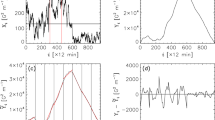Here, we performed a statistical analysis of the parameters describing the transverse component of the longitudinal magnetic field gradient (∇ ⊥ B z ) in the active regions of the AR – the AR-averaged transverse component of the longitudinal magnetic field gradient <∇ ⊥ B z >, the average transverse component of the longitudinal magnetic field gradient in the vicinity of a point with its maximum value <max∇ ⊥ B z >, the maximum value of the transverse component of the longitudinal magnetic field gradient between pairs of spots in the AR max(∇ ⊥ B z ) sp . For calculating the denoted parameters, magnetograms of the B z -components of the magnetic field vector at the level of the Sun’s photosphere obtained by the Helioseismic and Magnetic Imager (HMI) on board the Solar Dynamics Observatory (SDO) are used. The statistical sample contains data on 75 ARs. The values of the analyzed parameters obtained over the time of monitoring are compared with the level of flare productivity of the AR (the flare index FI). It is shown that: 1. The \(\langle \overline{{\nabla }_{\perp }{{\varvec{B}}}_{z}}\rangle \) -FI dependence (the overhead line denotes averaging over the time of monitoring the AR) is quadratic with a correlation coefficient k = 0.54 while the spread in values of the quantity \(\langle \overline{{\nabla }_{\perp }{{\varvec{B}}}_{z}}\rangle \) is small (lying within a a range of 0.08-0.12 G km-1 for the overwhelming majority of the studied regions) and differs very little for regions with low and high flare productivity, which may be explained by the dependence of ∇ ⊥ B z on the area of the AR. 2. The dependence \(\langle \overline{{\text{max}}{\nabla }_{\perp }{{\varvec{B}}}_{z}}\rangle \) -FI is quasilinear with a correlation coefficient k = 0.61. 3. The dependence \(\overline{{\text{max}}{\nabla }_{\perp }{{\varvec{B}}}_{z}}\) -FI is linear with a correlation coefficient k = 0.63. 4. The threshold values of the analyzed parameters are found: for \(\langle \overline{{\nabla }_{\perp }{{\varvec{B}}}_{z}}\rangle \) ≥ 0.078 G km-1, for \(\langle \overline{{\text{max}}{\nabla }_{\perp }{{\varvec{B}}}_{z}}\rangle \) ≥ 0.983 G km-1, and for the parameter max(∇ ⊥ B z) sp ≥ 0.118G km-1. For lower values of the analyzed parameters, no x-ray flares were recorded in any of the ARs of the analyzed sample.
Similar content being viewed by others
References
Yu. A. Fursyak, Astrophysics 66, 532 (2023).
Yu. A. Fursyak, Izv. Krymsk. Astrofiz. Obs. 118, 39 ( 2022).
P. H. Scherrer, J. Schou, R. I. Bush, et al., Solar Phys. 275, 207 (2012).
W. D. Pesnell, B. J .Thompson, and P. C. Chamberlin, Solar Phys. 275, 3 (2012).
M. B. Bobra, X. Sun, J. T .Hoeksema, et al., Solar Phys. 289, 3549 (2014).
A. V. Zhukova, Izv. Krymsk. Astrofiz. obs. 114, 74 (2018).
V. I. Abramenko, A. V. Zhukova, and A. S. Kutsenko, Geomagnetism and Aeronomy 58, 1159 (2018).
V. I. Abramenko, Mon. Not. Roy. Astron. Soc. 507, 3698 (2021).
V. I. Abramenko, Astrophys. J. 629, 1141 (2005).
A. B .Severnyi, Izv. Krymsk. Astrofiz. Obs. 20, 22 (1958).
A. B. Severnyi, Izv. Krymsk. Astrofiz. Obs. 22, 12 (1960).
A. M. Zvereva and A. B. Severnyi, Izv. Krymsk. Astrofiz. Obs. 41-42, 97 (1970).
Author information
Authors and Affiliations
Corresponding author
Additional information
Translated from Astrofizika, Vol. 67, No. 1, pp. 77-89 (February 2024)
Rights and permissions
Springer Nature or its licensor (e.g. a society or other partner) holds exclusive rights to this article under a publishing agreement with the author(s) or other rightsholder(s); author self-archiving of the accepted manuscript version of this article is solely governed by the terms of such publishing agreement and applicable law.
About this article
Cite this article
Fursyak, Y.A. Transverse Gradients of Longitudinal Magnetic Field in Active Regions with Different Levels of Flare Productivity. II. Statistical Analysis. Astrophysics 67, 67–79 (2024). https://doi.org/10.1007/s10511-024-09818-1
Received:
Accepted:
Published:
Issue Date:
DOI: https://doi.org/10.1007/s10511-024-09818-1



